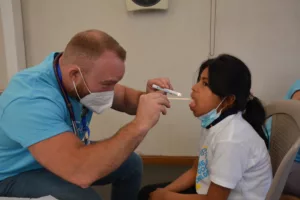Seasonal Sniffles and Sore Throats: How to Tell If It’s Strep Throat
Spring is here at last – bringing flowers, warmer weather, and…strep? It’s true that strep throat is common throughout the winter, but there always seems to be another peak in April and May. However, not every sore throat is caused by strep – but how do we know? What are the clues that doctors look for?
One of the things I like best about working in a concierge medical practice is having the time to explain my own clinical reasoning to patients – why I think about a specific diagnosis and what sways me towards or against it, or why I choose one treatment over another. In some cases, we have tools that we use to help us make a diagnosis.
How Do We Know If It’s Strep Throat?
In the case of strep, we actually have a scoring system called the modified Centor criteria in patients over 3 years old that helps us determine the risk of infection with Group A Strep – the bacteria that causes “strep throat.” We take into account age, presence of fever, tonsillar exudate (white spots on the tonsils), and enlarged lymph nodes. We also give you a point if you aren’t coughing – as coughing is more common with viral infections and allergies and relatively rare with strep! I find this most helpful when the picture is not entirely clear.

Photo by Angels for Humanity on Unsplash
It’s actually easier with a very high or very low score. If the probability of strep infection is less than 10% we often recommend skipping the swab altogether! If the score is very high – and I think there is a strong probability that this is really strep – but the test is negative, I might send a culture to make sure the test isn’t a false negative. Rarely I will treat even without a positive test – if everyone else in the house has strep but one sibling has a negative test but all the symptoms, I might recommend going ahead and treating.
While no calculators or algorithms are perfect this one is useful. However, I am hoping for a mild spring illness season and that I don’t have to use it often this year – after this winter we all could use a break!
